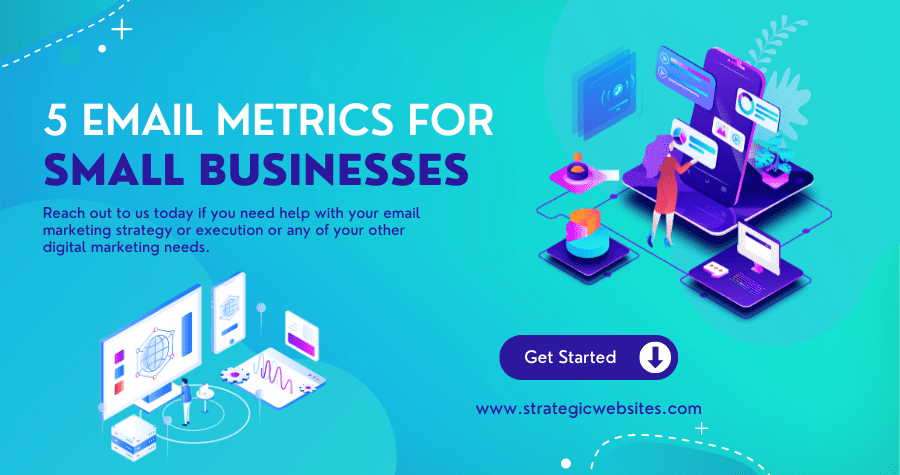We know you are already running an email marketing campaign. Despite changes to digital marketing over the past few years, email marketing remains one of the most effective ways to reach your customers. You’re a savvy small business owner, so this isn’t news to you.
But are you getting everything you can out of your email marketing campaigns? Getting an email marketing list going is only the first step. Once everything is up and running, this is where the real fun begins.
Unlike mailing lists in the past, email marketing lists aren’t sent out blindly into the world. You don’t have to wait days or weeks to see if your customers opened the mail, used a coupon, or responded to a mailed advertisement.
Email marketing campaigns are chock full of valuable data and insights about what’s working or not. You could spend your entire week combing through the data every week. But you’re a small business owner, juggling many hats, and don’t have that much time to look through things. That’s OK.
That’s what we’re here to help you with today. Knowing why you need this data and what to look at will help you get more value and performance from your email marketing campaigns.
Why Are Email Engagement Metrics So Important?
Or
Why You Can’t Afford Not to Track Email Engagement Metrics
One of the best things about digital marketing is that nothing has to be done by guesswork. If you want to know if something is working or not, you simply need to dig into the data.
However, many people are neglecting this feature. At most, many will only check their email engagement analytics to know how many people are reading their emails. And that’s where they stop – leaving tons of valuable insights unseen.
When you run a small business, every marketing spend matters. You don’t have millions to burn on a new campaign. You need the most significant possible results from the lowest spend. Email engagement analytics can help you find ways to optimize your email marketing campaigns so that you can do more with less.
Have a bunch of people not opening your emails? Stop spending to send them messages. Need to justify why you’re emailing a specific segment of your customer base? Use email marketing benchmarks to help other stakeholders understand your decision-making.
Many metrics are available, and people have entire careers just handling email marketing campaigns. So, to help you optimize your time better, here are five of the most important metrics to watch out for and how to use them.
The Top 5 Metrics to Track
or
Track These Five Email Engagement Metrics
1. Open Rate
Open rate is pretty self-explanatory. This is the percentage of recipients who have decided to open your email. If you sent 1,000 emails out and 200 customers opened those emails, you’d have an open rate of 20%. This is unique opens, so if one customer opens an email multiple times, it won’t be tracked in this data.
If you dive into your data and see low rates, don’t worry just yet. The average email open rate across all industries is just below 17%.
How can you improve your email marketing open rates? Use best practice guidelines for email subject lines, catchy content, and design, like:
- Segmenting your list so that groups receive targeted messaging
- Keeping your subject lines short and snappy
- Testing out the best times of day to send to your target audience
- Asking subscribers how often they’d like to receive emails from your company
- Ensuring your content and offers are compelling and competitive
2. Bounce Rate
Bounce rate is the percentage of emails you send that can’t be delivered to your audience. Multiply the number of emails sent by 100 and divide that number by the total number of emails that bounced back.
Email bounces are divided into two categories:
Soft bounce: a temporary issue that kept the email from going through. Maybe the email was too large, and their inbox didn’t allow it, or their email server was full or down for a moment.
Hard bounce: emails that can’t deliver due to permanent issues like bad email addresses or typos.
Ideally, a bounce rate of 2% or lower is considered healthy.
If your percentage is higher, here are some ways you can reduce your email bounce rates:
- Remove hard bounce emails from your list
- Stop sending emails from free email account platforms like Hotmail or Yahoo
- Ask your subscribers about their preferred consistency, so you don’t oversend
- Ensure your email address is verified with your email provider
- Avoid using spammy subject lines or content that could appear as spam
3. Click-Through Rate
Click-through refers to how many people click a link inside an email. You should never send emails without a clear CTA (call to action). Your email marketing campaigns are used to update customers on new products and offers, so tracking what motivates the most clicks is essential for your business.
To calculate your click-through rate, multiply the number of links clicked by 100 and divide by the number of emails sent out. If 1000 emails are sent, and 80 links are clicked, you have an 8% click-through rate.
Click-through rates across all industries are rather low at 2.69%. So, if you’re around this number, pat yourself on the back!
Improve your click-through rates with these tips:
- Don’t confuse your customers. Focus on one call-to-action per email
- Improve your design so that your CTA is clearly visible and accessible on mobile devices
- Offer substantial rewards and incentives to entice customers to click
- Ensure your subject lines and content match (never bait and switch)
- A/B test your results to try out different subject lines or copy and find what works best
4. Spam Rate
Spam rate is when your emails are marked as spam by your recipient. This can be terrible for your business. If too many emails are labeled in this way, it could see your emails being flagged and blocked for other recipients.
To calculate your spam rate, multiply the number of users who flagged an email as spam and multiply by 100. Divide this number by the number of emails delivered to your customers. So if you sent 1000 emails and 3 flagged you as spam, you’d have a 0.3% spam rate.
Spam rates need to be low. Around 0.1% is an acceptable percentage. If your spam rate is higher, you should take steps to address this issue immediately, as it could indicate some server problems, like:
- Your content isn’t connecting with customers
- People are losing interest in your brand or offerings
- Your body content isn’t delivering on what the subject line promised
- You’re using spam trigger words in your subject lines
Improve your spam report rates with these tips:
- Have a clear unsubscribe link that’s easy to use (people will report spam if they want to unsubscribe and can’t find a way to do it)
- Use double opt-ins to ensure people really want to be subscribed
- Asking customers to approve your emails with their email service provider
- Send only relevant, necessary emails
- Never email people who haven’t explicitly requested to subscribe to your email marketing list
5. Conversion Rate
Conversion rate is the holy grail of metrics. Not only did they read your email and click the link, but they also made a purchase or whatever metric you used to confirm a successful conversion. This could be downloading marketing materials, leaving a review, or applying a coupon code.
Conversion goals vary widely based on your industry, type of business, etc. But all companies should have clear goals in mind for every email they send out. Ask yourself, “What is the ideal scenario from this email?” Would you love it if a customer bought the new product, or what specific action is most important? Then, design your email’s content, CTA, and everything else to lead to this event.
Establish your current baseline, and then seek to improve it constantly. After all, you want to ensure you get the most value from your marketing budget.
Tips to help improve your email conversion rates:
- Clearly define the benefits to your audience for taking the specific action
- Use active, dynamic language in call-to-action links
- Use social proof, like customer reviews and testimonials
- Limit every email to one clear CTA
- Make your content scannable by keeping paragraphs and sentences short
Get Started Optimizing Your Email Marketing Campaigns!
Whatever your business size, you need to use email marketing as part of your digital marketing strategy. To further improve the returns on your spending, you must optimize your campaigns by measuring and analyzing the data.
Use the industry standard numbers as a starting point, but be sure to establish your own benchmarks. Many industries have wildly different rates and figures. Something super popular and cheap will always garner more clicks than a service that sells five times yearly.
While data can seem cold and impersonal, try to see your customers behind the numbers. It might not seem like it, but you can really learn a lot about who they are, how they operate, and what drives them through the data.
If this is too much for you, you can always offload some of your digital marketing needs to us. We love helping small businesses thrive online.
Reach out to us today if you need help with your email marketing strategy or execution or any of your other digital marketing needs.





